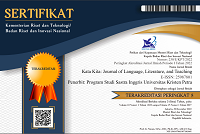READING MASCULINITY ON 9GAG
DOI:
https://doi.org/10.9744/katakita.4.3.52-59Keywords:
Online Shop Chatbox, Social Media, Website, Customer ServiceAbstract
This study is conducted to reveal the masculine qualities stereotyped on 9GAG by 9GAG users. There are two main theories used in analyzing this study, gender stereotype and denotation & connotation. (). First, the gender stereotype concepts used are from Brannon (2004) and Wood (2008). The first part of the study discusses 9GAG popular posts which content subtly contains of Alpha Male qualities. The result is the users show preferences on conventional masculine qualities. The second part of the study discusses 9GAG popular posts which content subtly contains of Beta Male qualities. The result is there are some specific feminine or Beta Male sides 9GAG users accept in men. In conclusion, 9GAG users still focus more on masculine qualities, especially masculine physical features, in men. Feminine qualities in men can be accepted by the community if men possess the conventional masculine physical features first.
References
Alpha Male Body Language. (n.d.). Retrieved from http://www.tobealpha.com/alpha-male-body-language/
Alpha Male Characteristics. (n.d.). Retrieved from http://www.tobealpha.com/alpha-male-characteristics/
Brannon, L. (2004). Gender Stereotypes: Masculinity and Femininity. In Gender: Psychological Perspectives (4th ed.). Boston, Massachusetts: Allyn & Bacon.
Chandler, D. (1994). Retrieved from Semiotics for Beginners: http://visual-memory.co.uk/daniel/Documents/S4B/sem06.html
Madsen, A. (2012, March 12). The Alpha Male & Beta Male. Retrieved from http://elitedaily.com/life/culture/alpha-beta-males-comp/
Wood, J. (2008). Gendered Lives: Communication, Gender, and Culture (8th ed.). Boston, Massachusetts: Wadsworth Cengage Learning.
Downloads
Issue
Section
License
Authors who publish with this journal agree to the following terms:- Authors retain copyright and grant the journal right of first publication with the work simultaneously licensed under a Creative Commons Attribution License that allows others to share the work with an acknowledgement of the work's authorship and initial publication in this journal.
- Authors are able to enter into separate, additional contractual arrangements for the non-exclusive distribution of the journal's published version of the work (e.g., post it to an institutional repository or publish it in a book), with an acknowledgement of its initial publication in this journal.
- Authors are permitted and encouraged to post their work online (e.g., in institutional repositories or on their website) prior to and during the submission process, as it can lead to productive exchanges, as well as earlier and greater citation of published work (See The Effect of Open Access).














